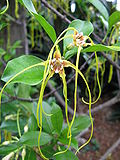Strophanthus
Strophanthus is a genus of flowering plants in the family Apocynaceae, first described as a genus in 1809. It is native to tropical regions of Africa and Asia. The name Strophanthus comes from the Greek words strophos (a twisted cord) and anthos (flower), referring to the long twisted threadlike segments of the corolla.
Description[edit]
Strophanthus species are shrubs, lianas or small trees. The leaves are opposite or whorled, simple broad lanceolate, 2–20 cm long, with an entire margin. The flowers are produced in open cymes, with a five-lobed white, pink, or red corolla, typically twisted in the bud, hence the genus name. The fruit is a pair of follicles 5–40 cm long, containing numerous seeds; each seed has a tuft of silky hairs at one end, which aids wind dispersal.
Uses[edit]
Several species are used in traditional medicine in their native regions; some species are used to produce arrow poisons. The seeds of Strophanthus kombe and Strophanthus gratus are the source of the drug strophanthin.
Species[edit]
There are about 38 species in the genus, including:
- Strophanthus boivinii
- Strophanthus caudatus
- Strophanthus divaricatus
- Strophanthus gratus
- Strophanthus hispidus
- Strophanthus kombe
- Strophanthus petersianus
- Strophanthus preussii
- Strophanthus sarmentosus
- Strophanthus speciosus
- Strophanthus thollonii
- Strophanthus wallichii
References[edit]
<references />
Ad. Transform your life with W8MD's Budget GLP-1 injections from $75


W8MD offers a medical weight loss program to lose weight in Philadelphia. Our physician-supervised medical weight loss provides:
- Weight loss injections in NYC (generic and brand names):
- Zepbound / Mounjaro, Wegovy / Ozempic, Saxenda
- Most insurances accepted or discounted self-pay rates. We will obtain insurance prior authorizations if needed.
- Generic GLP1 weight loss injections from $75 for the starting dose.
- Also offer prescription weight loss medications including Phentermine, Qsymia, Diethylpropion, Contrave etc.
NYC weight loss doctor appointmentsNYC weight loss doctor appointments
Start your NYC weight loss journey today at our NYC medical weight loss and Philadelphia medical weight loss clinics.
- Call 718-946-5500 to lose weight in NYC or for medical weight loss in Philadelphia 215-676-2334.
- Tags:NYC medical weight loss, Philadelphia lose weight Zepbound NYC, Budget GLP1 weight loss injections, Wegovy Philadelphia, Wegovy NYC, Philadelphia medical weight loss, Brookly weight loss and Wegovy NYC
|
WikiMD's Wellness Encyclopedia |
| Let Food Be Thy Medicine Medicine Thy Food - Hippocrates |
Medical Disclaimer: WikiMD is not a substitute for professional medical advice. The information on WikiMD is provided as an information resource only, may be incorrect, outdated or misleading, and is not to be used or relied on for any diagnostic or treatment purposes. Please consult your health care provider before making any healthcare decisions or for guidance about a specific medical condition. WikiMD expressly disclaims responsibility, and shall have no liability, for any damages, loss, injury, or liability whatsoever suffered as a result of your reliance on the information contained in this site. By visiting this site you agree to the foregoing terms and conditions, which may from time to time be changed or supplemented by WikiMD. If you do not agree to the foregoing terms and conditions, you should not enter or use this site. See full disclaimer.
Credits:Most images are courtesy of Wikimedia commons, and templates, categories Wikipedia, licensed under CC BY SA or similar.
Translate this page: - East Asian
中文,
日本,
한국어,
South Asian
हिन्दी,
தமிழ்,
తెలుగు,
Urdu,
ಕನ್ನಡ,
Southeast Asian
Indonesian,
Vietnamese,
Thai,
မြန်မာဘာသာ,
বাংলা
European
español,
Deutsch,
français,
Greek,
português do Brasil,
polski,
română,
русский,
Nederlands,
norsk,
svenska,
suomi,
Italian
Middle Eastern & African
عربى,
Turkish,
Persian,
Hebrew,
Afrikaans,
isiZulu,
Kiswahili,
Other
Bulgarian,
Hungarian,
Czech,
Swedish,
മലയാളം,
मराठी,
ਪੰਜਾਬੀ,
ગુજરાતી,
Portuguese,
Ukrainian













